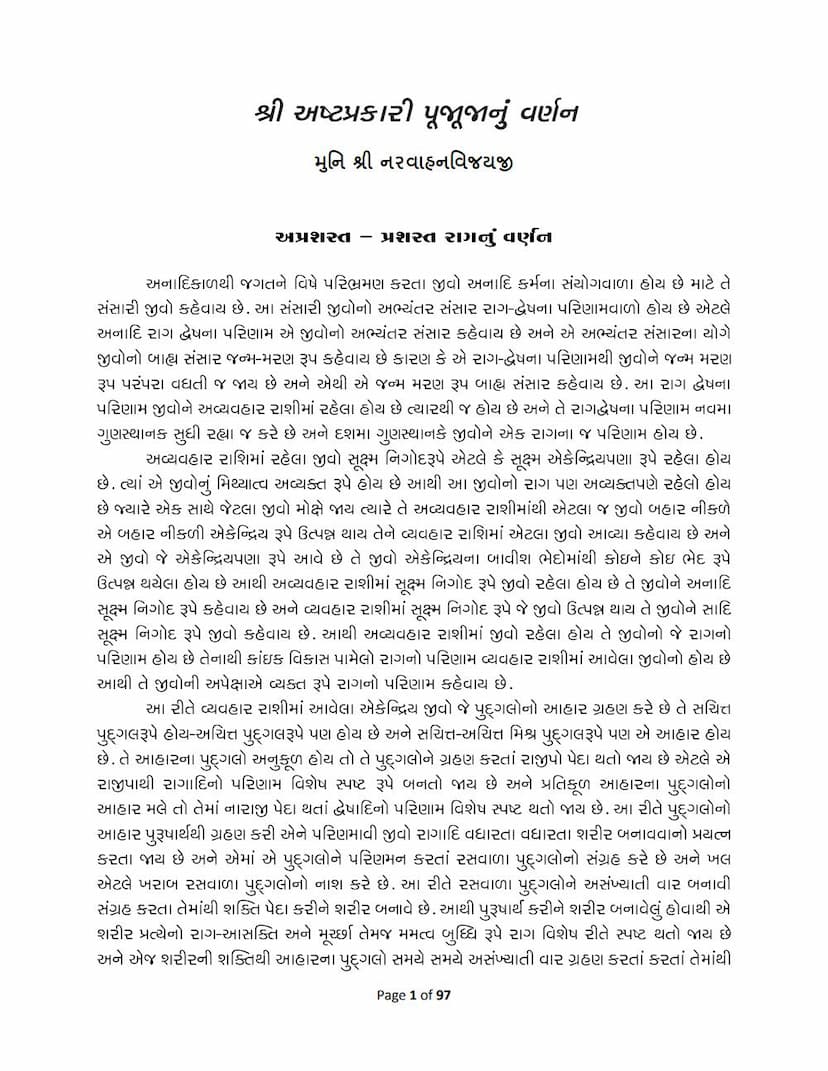Ashta Prakari Pujanu Varnan
Added to library: September 1, 2025

Summary
This document is a detailed description of the "Ashta Prakari Puja" (Eightfold Puja) in Jainism, authored by Muni Narvahanvijayji. It elaborates on the significance and proper performance of each of the eight types of worship, emphasizing the underlying spiritual principles and the intended outcomes for the devotee.
The text begins by discussing the cyclical nature of existence (samsara) driven by attachment (raag) and aversion (dwesh), which lead to birth and death. It explains how souls progress through various stages of existence, from the most basic (ekendriya) to more complex forms, influenced by their karmic attachments and the development of their senses and mind.
The core of the text focuses on the eight types of puja, providing a step-by-step guide and the philosophical rationale behind each:
-
Water Puja (Jal Puja): This puja is described as a means to purify oneself from karmic impurities (karma-mal). The text emphasizes performing it with devotion and a clear understanding of the soul's need for purification, likening it to the cleansing power of water. It details the process of anointing the deity with water and Panchamrit (a mixture of five auspicious items), highlighting the importance of using pure water and the intention behind the ritual. The ultimate goal is to reduce the attachment to worldly pleasures and cultivate detachment.
-
Sandalwood Puja (Chandan Puja): This puja aims to invoke coolness and peace within the soul by offering sandalwood paste. It symbolizes the overcoming of internal and external heat (taap) caused by afflictions like desire and anger. The text explains that true coolness comes from spiritual practices that pacify these afflictions, leading to inner peace and a detachment from worldly suffering.
-
Flower Puja (Phool Puja): This puja is about cultivating purity of mind and intention, symbolized by offering fresh, fragrant flowers. It emphasizes using flowers without harming living beings and treating them with respect. The puja is seen as a way to develop pure thoughts and intentions, leading to a fragrant inner state and contributing to spiritual progress. It also touches upon the story of King Kumarpal to illustrate the power of devotion and detachment.
-
Incense Puja (Dhoop Puja): This puja symbolizes the burning away of karmic impurities, likening the incense smoke to the rising soul purified through meditation and righteous thoughts. It explains how incense removes negative energies and creates a pure atmosphere, promoting spiritual upliftment by destroying negative thoughts like anger and envy.
-
Lamp Puja (Deep Puja): This puja represents the dispelling of ignorance and the illumination of the soul's inner knowledge. The lamp's flame symbolizes the light of right faith, knowledge, and conduct. It aims to awaken the soul's inherent brilliance and clarity, leading to a discerning mind and the ability to distinguish between what is beneficial and what is detrimental.
-
Unbroken Rice Puja (Akshat Puja): Offering unbroken rice symbolizes the desire for unbroken spiritual progress and eternal happiness, like the unbroken state of the Siddhas (liberated souls). It represents the aspiration for wholeness and continuity in spiritual practice, free from fragmentation. It highlights the importance of purity of intention and the desire for ultimate liberation.
-
Sweets/Food Offering Puja (Naivedya Puja): This puja focuses on conquering the attachment to food and sensory pleasures (aahar sangya). It emphasizes the importance of eating with detachment and understanding that food is for sustenance, not for indulgence. The puja encourages the aspiration for a state of being free from the need for physical sustenance (anahari-pana), a state attained by the liberated souls.
-
Fruit Puja (Phal Puja): This puja symbolizes the relinquishment of possessions and attachments (parigraha). It emphasizes the transient nature of worldly possessions and the importance of non-attachment. By offering fruits, the devotee expresses the desire to detach from material attachments and cultivate equanimity, aiming for the ultimate state of non-possession (aparigraha).
The text also includes detailed instructions on the correct way to perform these pujas, including purity of body, clothes, mind, and the environment. It stresses the importance of devotion, reverence, and the right intention (bhav) behind the actions, as mere ritual without the proper inner state will not yield the desired spiritual benefits.
Finally, the document provides verses (duhas) summarizing the essence of each puja and concludes with a discussion on "Chaitya Vandan" (veneration of the sacred shrine), reinforcing the idea that the ultimate goal of all these practices is to achieve spiritual liberation (moksha).